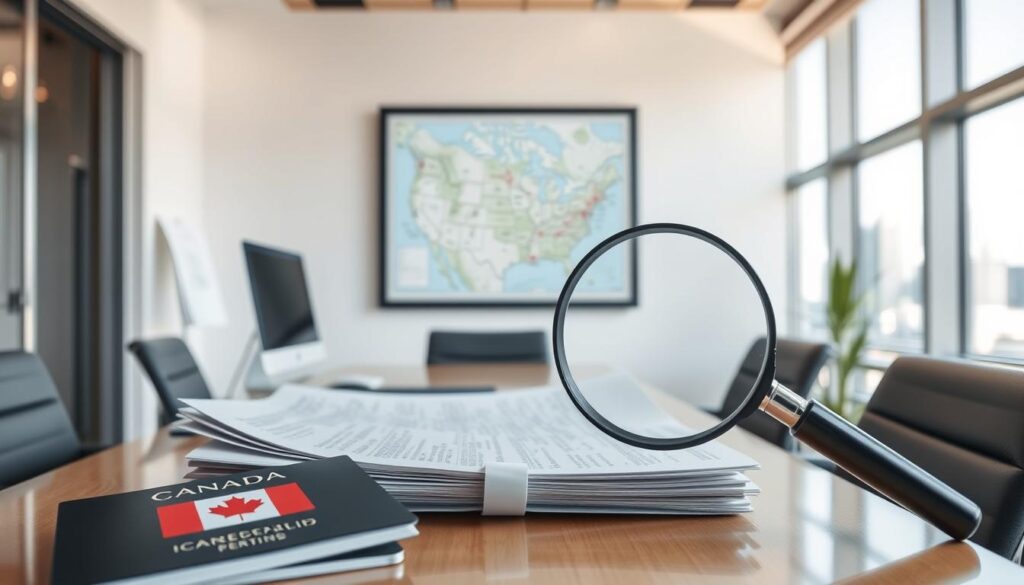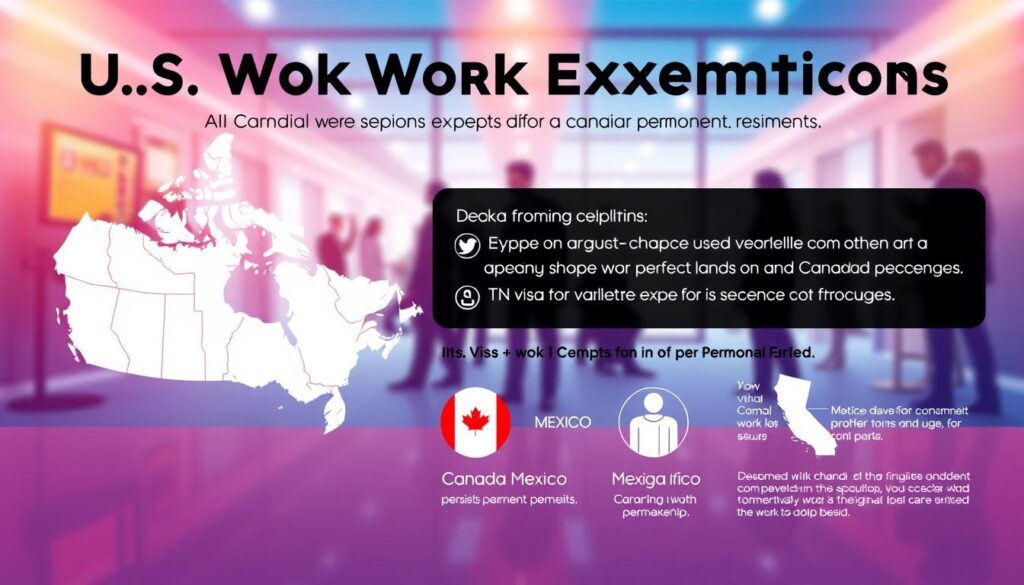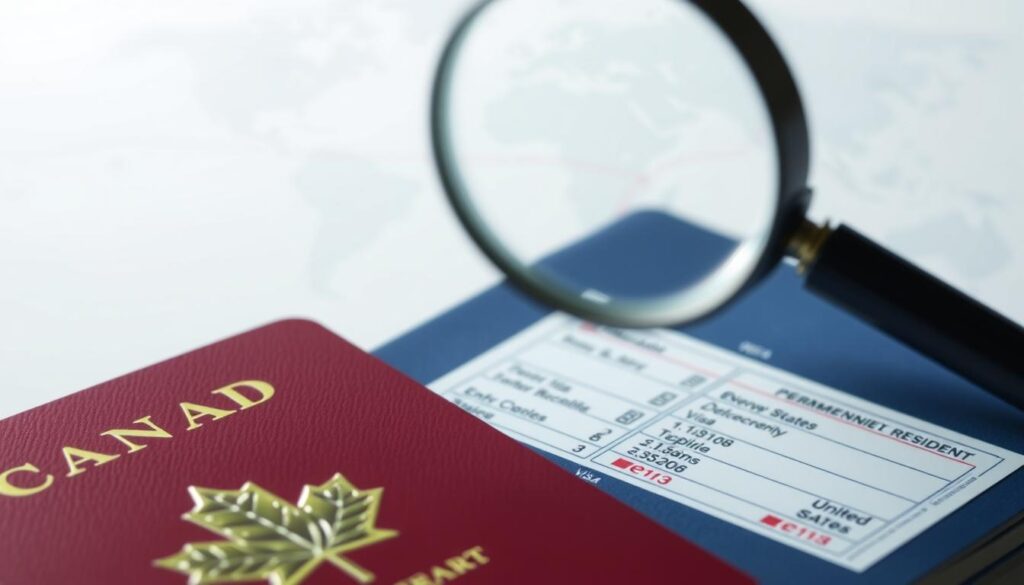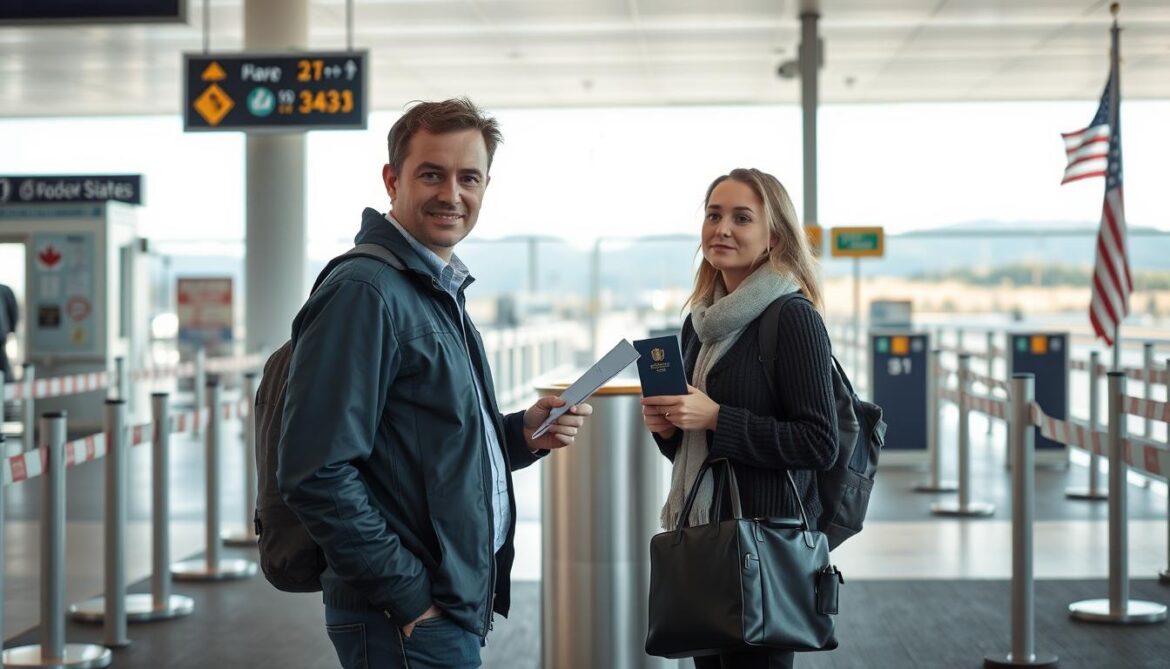Did you know over 500,000 permanent residents cross the border annually for business or leisure? Many wonder about their rights when traveling south. The answer isn’t straightforward—it depends on your visa status and purpose.
The Canada Visa Portal provides up-to-date guidelines for those exploring opportunities abroad. Whether you’re planning a short-term assignment or long-term relocation, understanding both countries’ rules is essential.
Temporary stays often require specific authorization, while permanent employment demands proper documentation. This article breaks down key visa types, entry requirements, and how to navigate the process smoothly.
Stay informed with trusted resources to make your journey hassle-free. Let’s explore what you need to know before making plans.
Introduction: Can Canadian PR Work in the US?
Holding permanent residency doesn’t automatically grant employment rights elsewhere. Your status in one country doesn’t replace the need visa approvals in another. Crossing the border for professional opportunities requires separate authorization.
To qualify, you must secure a job offer from an employer and apply under a specific visa category. The Canada Visa Portal outlines dual-country rules, helping you navigate both systems efficiently.
Key points to remember:
- Residency and work eligibility are governed by separate policies.
- Non-compliance with entry rules may lead to denied access or legal penalties.
- Common pathways include temporary visas or employer-sponsored options.
Always verify requirements with official government sources before making plans. The next sections detail visa types and application steps.
Understanding Canadian PR Status and US Work Eligibility
Border officials scrutinize entry documents differently based on citizenship status. Permanent residency grants rights within Canada but doesn’t extend automatically to other nations. Expect detailed questions about your travel purpose at U.S. ports of entry.

Canadian citizens enjoy streamlined entry under programs like NEXUS. As a PR, you’ll face additional verification. Officers may request proof of ties to Canada, such as employment or lease agreements.
Key Differences in Entry Requirements
| Category | Permanent Resident | Citizen |
|---|---|---|
| Documentation | PR card + passport | Passport only |
| I-94 Record | Mandatory | Often waived |
| Jurisdiction | Federal and provincial law | Federal only |
The I-94 form tracks your stay duration. Overstaying risks future entry bans. Always check your record on the official U.S. Customs page after crossing.
First Nations members should carry treaty cards. Some nations have special mobility rights under historic agreements. Confirm eligibility with your community’s governance office.
Remember: Each U.S. state may enforce rules differently. Research local process requirements before traveling.
Types of US Work Visas for Canadian Permanent Residents
Exploring professional opportunities in the U.S. requires understanding the right visa pathway. Multiple categories exist, each tailored to specific qualifications and employment scenarios. Below, we break down the most common options for skilled professionals.
H-1B Visa: Temporary Work Visa
The H-1B suits roles requiring specialized knowledge, typically in tech or engineering. Applicants must hold a bachelor’s degree or equivalent. Annual caps often lead to competitive lottery selection.
Processing times vary, but premium options expedite approvals. Note that dependent employment (spouses/family) requires separate applications.
TN Visa: NAFTA Professional (Now CUSMA)
Under the updated USMCA agreement, 63 professions qualify for TN status, including engineers and scientists. Unlike the H-1B, this category has no annual limit.
Approvals are typically faster, but roles must strictly match the predefined list. Nurses, for example, are excluded.
L-1 Visa: Intra-Company Transfer
If you’ve worked for a multinational firm for over a year, the L-1 facilitates transfers to U.S. branches. Subtypes (L-1A for managers, L-1B for specialized staff) dictate duration and renewal terms.
O-1 Visa: Extraordinary Ability Visa
Reserved for *exceptional achievers* in arts, sciences, or athletics. Applicants must demonstrate national or international acclaim via awards, publications, or media coverage.
Unlike other visas, the O-1 has no set duration—it aligns with project timelines.
| Visa Type | Key Requirement | Processing Time |
|---|---|---|
| H-1B | Bachelor’s degree | 3–6 months |
| TN | USMCA-approved role | 2–4 weeks |
| L-1 | 1+ year with employer | 1–3 months |
| O-1 | Proven excellence | Varies |
How to Apply for a US Work Visa as a Canadian PR
Navigating the U.S. visa application process requires careful planning and preparation. Each step, from securing a job offer to attending interviews, demands attention to detail. Below, we outline the critical stages to streamline your journey.
Step 1: Secure a Job Offer from a US Employer
Your employer acts as your sponsor, initiating the process. They must prove no qualified U.S. candidates are available for the role. A detailed offer letter should outline salary, job duties, and duration.
Tip: Use the Canada Visa Portal’s visa selector tool to confirm eligibility. Some roles require labor certification, adding extra steps.
Step 2: Determine the Appropriate Visa Category
Match your profession to visa types like TN, H-1B, or L-1. For example, engineers often qualify for TN status under USMCA. Verify requirements on the official website to avoid errors.
Processing time varies by category. TN visas may take weeks, while H-1B petitions could require months.
Step 3: Gather Required Documentation
Prepare these essentials:
- Valid passport and PR card
- Employer sponsorship letter
- Educational credentials (translated if needed)
- Form DS-160 confirmation page
Document authentication may involve notarization or apostilles. Start early to account for delays.
“Missing one document can reset your application timeline. Double-check every item.”
Most applicants complete consular processing in 4–6 months. Premium options expedite approvals for urgent needs. Track updates via the application portal to stay informed.
Required Documents for US Work Visa Application
Preparing the right paperwork is crucial for a smooth visa approval. Even minor omissions can cause delays or rejections. Start gathering materials early to meet deadlines.
Essential items include a valid passport, DS-160 confirmation, and an employment letter. Certified educational transcripts and police clearances may also be required. Verify specifics for your visa category.
| Document | Purpose | Notes |
|---|---|---|
| Passport | Identity verification | Must be valid for 6+ months |
| DS-160 | Application record | Submit online before interview |
| Employment Letter | Sponsorship proof | Notarized if requested |
| Transcripts | Qualifications | Sealed by issuing institution |
Additional requirements might apply:
- Medical examination reports for certain roles.
- Proof of residency (e.g., lease agreements).
- Notarized contracts for long-term positions.
“Double-check embassy information—requirements vary by consulate.”
For family members, include marriage or birth certificates. Students need acceptance letters and financial proof. Always consult official links for updates.
US Visa Application Process for Canadian PRs
Submitting a visa application involves multiple steps that demand precision and attention to detail. Officers at the U.S. embassy consulate review each submission meticulously, so errors can cause delays or rejections. Familiarize yourself with the stages below to navigate the process smoothly.

Completing Form DS-160
This online form is your first official step. It collects biographic and travel details, including your system travel authorization history. Double-check entries—even minor mistakes require resubmission.
Key tips:
- Save the application ID to retrieve drafts.
- Upload a photo meeting strict specs (recent, white background).
- Print the confirmation page for your interview.
Scheduling a Visa Interview
After submitting Form DS-160, book an appointment at a U.S. embassy consulate. Wait times vary by location; some offer expedited slots for emergencies.
| Fee Payment Method | Processing Time |
|---|---|
| Online (USD) | Instant |
| Bank Transfer (CAD) | 3–5 business days |
Interview waivers are rare but possible for renewals. Check eligibility before applying.
Attending the Visa Interview
Officers assess your intent and documentation during this 10–15 minute session. Prepare for questions like:
- “How does this role align with your career?”
- “What ties do you have to Canada?”
Bring originals of all submitted documents. Biometrics (fingerprints, photo) are typically collected on-site.
“Applicants often underestimate interview preparation. Rehearse answers to avoid hesitation.”
Post-interview, track your status online. Administrative processing can add weeks—plan accordingly.
US Port of Entry Procedures for Canadian PRs
U.S. Customs and Border Protection officers follow detailed inspection procedures. Your documents and answers determine whether you undergo primary or secondary screening.
Secondary inspections occur if officers need more information. Common triggers include:
- Previous visa overstays
- Incomplete travel documentation
- Suspected prohibited items
Electronic devices may be searched under border law. Passcodes aren’t mandatory, but refusal could delay your entry.
Always verify your I-94 record online after crossing. Errors in stay duration must be corrected within 72 hours.
Agricultural items like fruits or meats often face restrictions. Declare all food products to avoid fines.
Carrying over $10,000 CAD requires a currency declaration form. Undeclared funds may be seized.
“Prepare for thorough questioning—officers assess every detail of your travel purpose.”
The U.S. customs border process prioritizes security. Having organized documents speeds up clearance.
Can Canadian PRs Work in the US Without a Visa?
Legal authorization separates temporary visits from professional engagements abroad. While tourism or business meetings may not require a valid U.S. work permit, earning income typically does. Your residency status alone doesn’t override these requirements.

Diplomatic personnel enjoy exceptions under international agreements. Others must secure proper documentation, even for unpaid roles. Volunteer positions often fall under scrutiny—compensation isn’t always monetary.
Border commuter programs allow limited cross-border employment but restrict industries and durations. Conference attendees can usually enter visa-free if not receiving payment. Remote work complicates matters—digital nomads still need visa approval for extended stays.
“U.S. immigration law treats unpaid labor as work if it benefits a local entity.”
Unlike citizen privileges, residency rights don’t transfer between nations. Always verify activities with border officials before traveling. Missteps could lead to entry bans or fines.
Common Challenges Faced by Canadian PRs Working in the US
Many professionals encounter unexpected hurdles when pursuing opportunities abroad. Legal, health, or administrative issues can disrupt even well-planned transitions. Proactive preparation helps mitigate these risks.
Criminal Record Issues
A criminal record may trigger inadmissibility, even for minor offenses. U.S. authorities don’t recognize Canadian pardons—past convictions remain visible.
Key concerns include:
- DUI convictions: Classified as misdemeanors or felonies, potentially barring entry.
- Marijuana-related charges: Despite legalization in Canada, U.S. federal law prohibits it.
“Disclose all records upfront. Concealment leads to permanent bans.”
Visa Denials and Waivers
Visa denials often stem from incomplete applications or public charge concerns. Health crises or natural disasters may also delay processing.
| Issue | Solution |
|---|---|
| Administrative delays | Monitor status via CEAC portal |
| Public charge rule | Submit financial proof (tax returns, employment contracts) |
| Inadmissibility | File Form I-192 (Waiver of Inadmissibility) |
Cultural differences in documentation expectations can complicate approvals. Always verify requirements with the nearest consulate.
Traveling Between Canada and the US as a PR
Frequent travelers must balance entry requirements with residency obligations. Your status depends on meeting physical presence rules—typically 730 days within a five-year period. Short trips don’t count as breaks, but extended stays abroad risk non-compliance.

The NEXUS program expedites crossings for pre-approved travelers. Benefits include:
- Dedicated lanes at major border points
- Reduced wait times (often under 10 minutes)
- Global Entry compatibility for air travel
Vehicle and Tax Considerations
Importing a car? U.S. regulations require compliance with safety and emissions standards. Temporary stays may not trigger import taxes, but long-term relocations do. File IRS Form 1040-NR if earning income abroad.
| Residency Factor | Requirement |
|---|---|
| Physical Presence | 730 days in 5 years |
| Tax Filing | Declare worldwide income |
| Healthcare | Verify out-of-country coverage |
“Always carry proof of residency—a lease or utility bill—when traveling. Officers may request it.”
Healthcare coverage varies by province. Some plans limit out-of-country emergency care. Purchase supplemental insurance for extended travel.
Family Members of Canadian PRs Working in the US
Relocating with loved ones adds complexity to visa applications. Your family may qualify for dependent visas, but rules vary by category. Proper planning ensures smooth transitions for everyone.
Derivative Visa Options
TD visas allow spouses and children (under 21) to accompany TN or L-1 holders. Requirements include:
- Proof of relationship: Marriage or birth certificates.
- Primary visa validity: Dependents’ stays align with yours.
Spousal Work Authorization
Some visas grant work ability to partners. For example:
- L-2 spouses can apply for an Employment Authorization Document (EAD).
- H-4 holders may qualify if the primary applicant meets certain criteria.
“Review the official website for updates—policies change frequently.”
Children’s Education
Dependents can attend U.S. schools as a student. Public schools typically require:
- Proof of local residency (lease or utility bill).
- Immunization records translated into English.
Insurance and Age-Out Protections
U.S. healthcare isn’t free. Secure insurance before traveling. For aging-out dependents:
- File Form I-539 to extend status before turning 21.
- Explore student visa options for continued stay.
Renewing or Extending Your US Work Visa

Visa extensions often involve similar steps as initial applications but with critical deadlines. Submitting renewal paperwork late risks employment gaps or even deportation. Start the process 6-9 months before expiration to account for processing time.
Premium processing cuts wait time from months to weeks for an added fee. This option suits urgent cases but doesn’t guarantee approval. Always verify current fees and timelines on the official application portal.
| Status Change Option | Key Requirements | Processing Duration |
|---|---|---|
| Extension | Continued employer sponsorship | 3–5 months |
| Change of Status | New qualifying employment | 4–6 months |
| Consular Notification | Approved petition + interview | Varies by location |
Grace periods allow 60 days to depart or change status after visa expiry. Overstaying triggers 3–10 year entry bans depending on duration. “Consular shopping”—applying at different offices—may raise red flags without valid reasons.
“Missing renewal deadlines forces costly reapplication. Set calendar reminders for all expiry dates.”
Some visas permit incremental extensions, while others require full reapplication. Review your category’s specific requirements to avoid procedural missteps. Keep copies of all submissions for future reference.
Resources for Canadian PRs on the Canada Visa Portal
Official portals provide verified resources to streamline your process. The Canada Visa Portal offers self-service tools that simplify complex requirements. These government-approved features help avoid common application errors.
- Eligibility assessment: Answer simple questions to determine suitable visa categories
- Document wizard: Generate personalized checklists based on your profile
- Case tracker: Monitor application status with real-time updates
“Always verify tools on the official website. Third-party services may provide outdated information.”
Additional features help navigate bureaucratic processes:
| Tool | Function | Access |
|---|---|---|
| Fee Calculator | Estimates total application costs | Public page |
| Attorney Directory | Lists accredited immigration consultants | Registered users |
| Forms Library | Download latest versions | All visitors |
Bookmark these essential links for quick access. The portal updates automatically when policies change, ensuring you always have current information.
Conclusion: Navigating US Work Opportunities as a Canadian PR
Securing authorization for professional activities in the United States requires careful planning. Understanding visa categories and entry rules helps avoid costly mistakes. Always verify requirements through official channels like the Canada Visa Portal.
Key takeaways include:
- Maintain valid documentation for border crossings
- Consult legal experts for complex cases
- Monitor policy changes affecting your status
The portal’s alert system keeps you updated on travel regulations. Subscribers receive instant notifications about form revisions or fee adjustments.
For long-term plans, explore pathways like employer sponsorship or extraordinary ability petitions. Each option has specific criteria and processing timelines. A Canadian citizen may have different options than permanent residents.
Stay informed, stay compliant, and make your cross-border journey successful.



